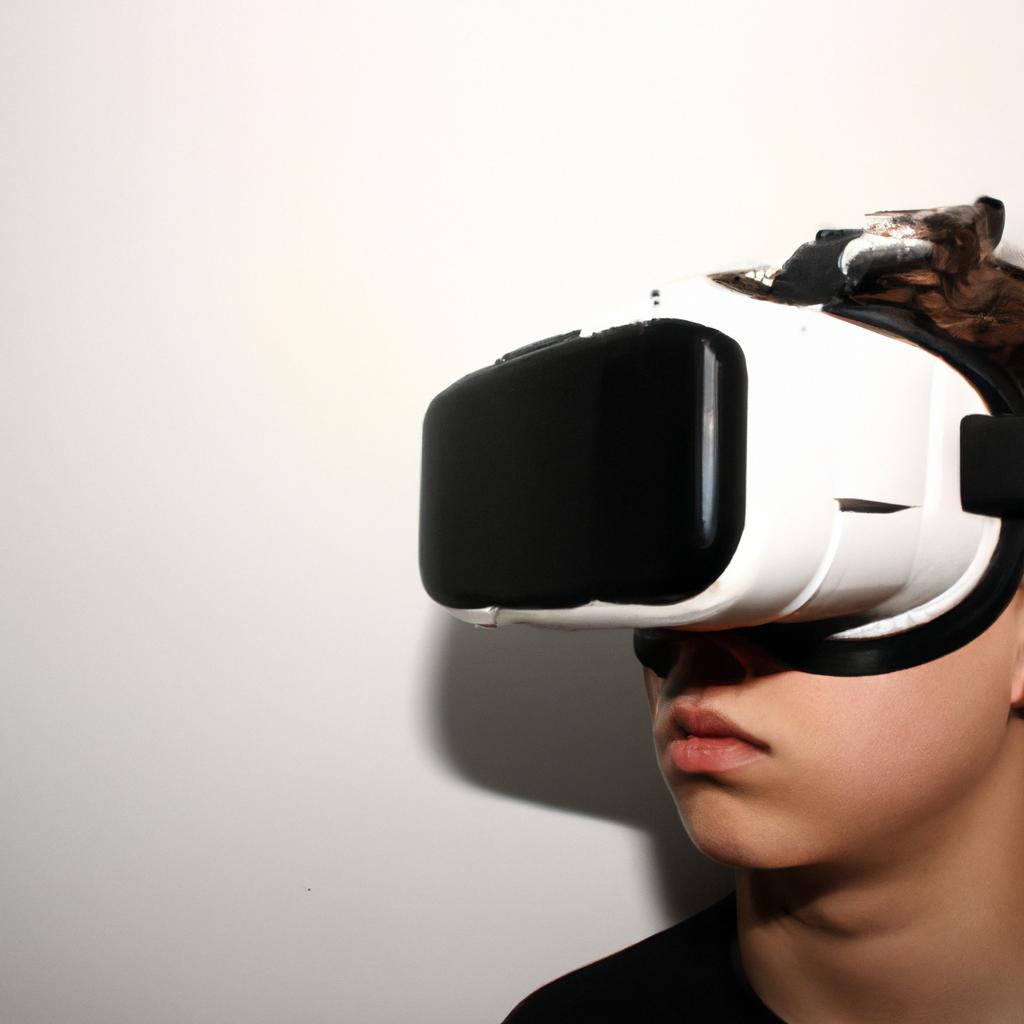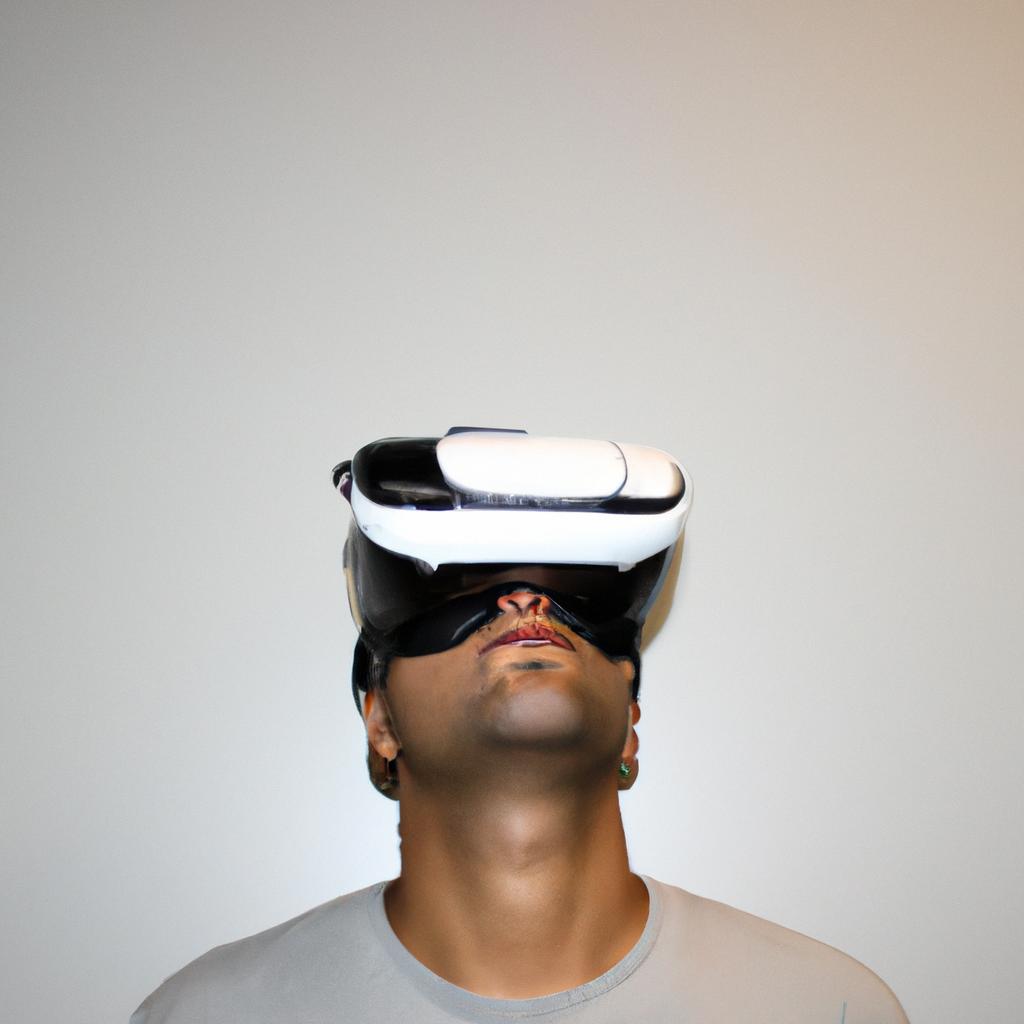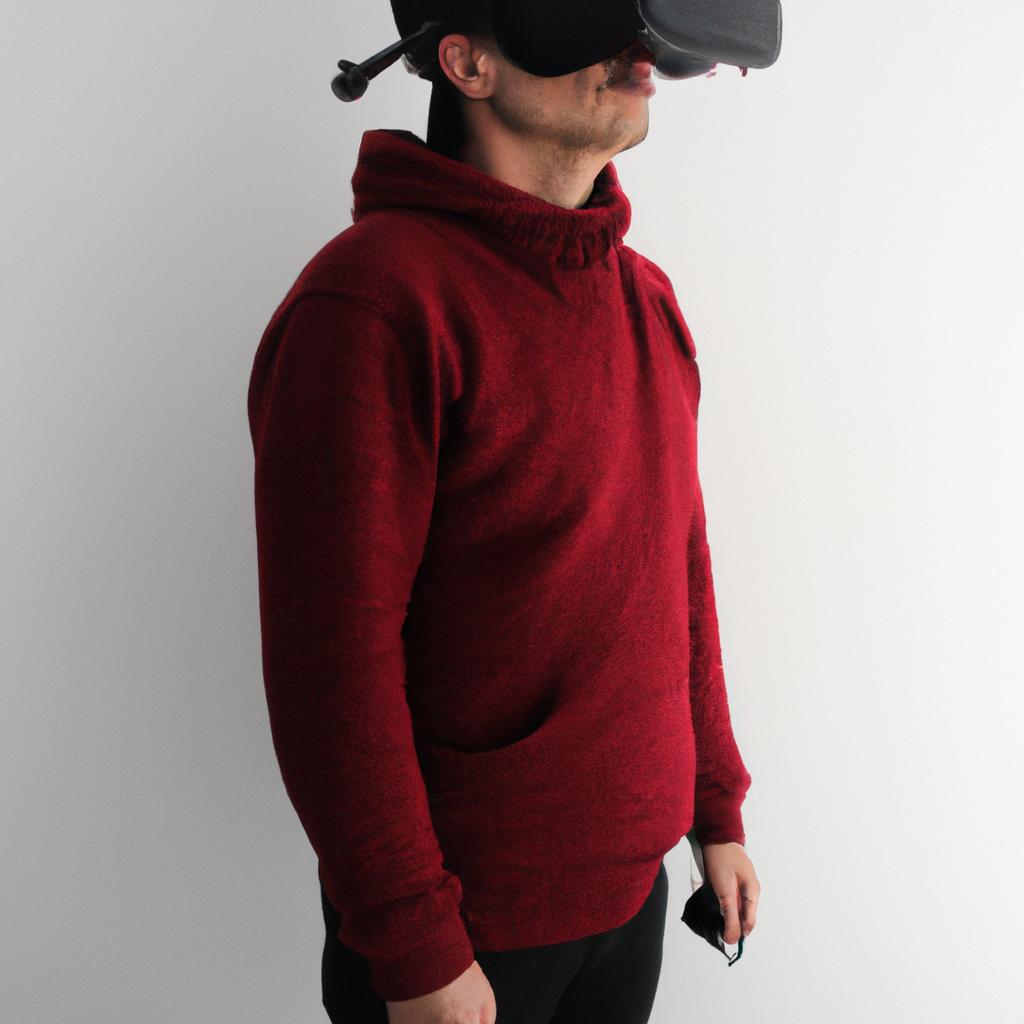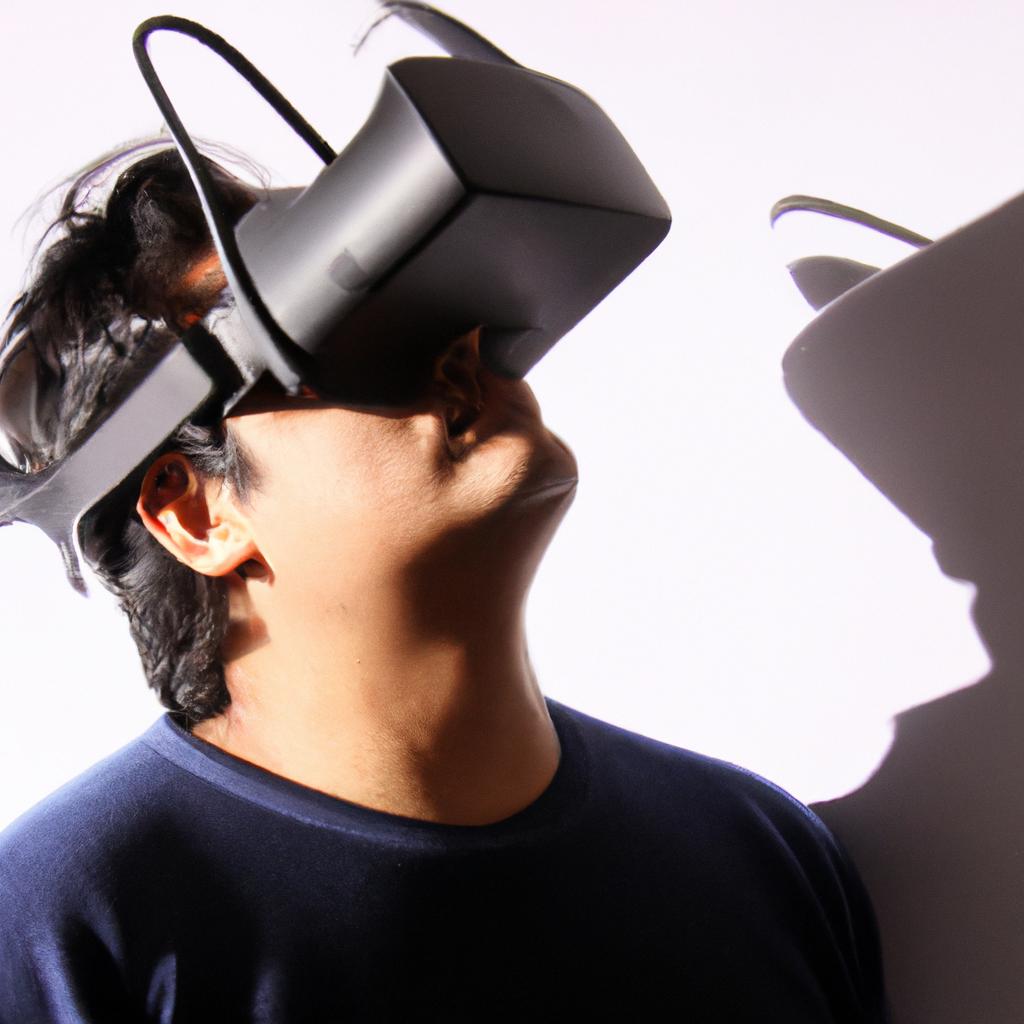Virtual Reality in Gaming: Enhancing the Game Experience

Virtual Reality (VR) has revolutionized the gaming industry, offering a unique and immersive experience for players. By simulating a three-dimensional environment that can be explored and interacted with, VR technology enhances the game experience by blurring the line between reality and virtuality. For instance, imagine stepping into a virtual world where you are transported to an ancient civilization or fighting off hordes of zombies in a post-apocalyptic landscape; these scenarios become possible through the power of VR.
The integration of VR technology in gaming opens up new possibilities for both developers and gamers alike. Through realistic graphics, spatial sound effects, and motion tracking devices, players are able to fully immerse themselves in their favorite games like never before. This level of immersion not only adds excitement but also deepens emotional engagement as players feel more connected to the game world. The ability to physically move within a virtual space creates a sense of agency and control, making gameplay more intuitive and natural. Furthermore, multiplayer experiences in VR bring social interaction to a whole new level, allowing players from different parts of the world to connect and compete in shared virtual environments.
In this article, we will explore how virtual reality is transforming the gaming industry by enhancing the overall game experience. We will delve into various aspects of VR gaming, including the hardware and software advancements that have made it possible, the impact of VR on game design and storytelling, and the potential future developments in this rapidly evolving field.
Firstly, let’s discuss the hardware aspect of VR gaming. Virtual reality headsets such as the Oculus Rift, HTC Vive, and PlayStation VR have become more accessible to consumers in recent years. These devices use high-resolution displays and advanced tracking systems to create a sense of presence within virtual environments. With improved ergonomics and comfort features, these headsets allow players to wear them for extended periods without discomfort. Additionally, hand controllers and motion tracking devices enable players to interact with objects in the virtual world using natural gestures and movements.
On the software side, game developers are utilizing cutting-edge technologies to optimize graphics and performance for VR experiences. They are leveraging techniques like real-time rendering, dynamic lighting, and spatial audio to create visually stunning and immersive worlds. The integration of physics-based interactions further enhances realism by simulating realistic object behaviors and environmental effects.
One significant impact of VR on game design is the shift towards player-centric experiences. Game designers now focus on creating gameplay mechanics that take advantage of the unique capabilities offered by VR technology. For example, puzzle-solving games can make use of intuitive hand gestures for manipulating objects or navigating through complex environments. First-person shooters can offer more immersive gunplay by requiring players to physically aim their weapons or duck behind cover.
Another area where virtual reality has had a transformative effect is storytelling in games. By placing players directly into the game world as an active participant rather than a passive observer, developers can evoke stronger emotional responses from players. Players feel more connected to characters and events when they experience them firsthand in virtual reality. This immersive storytelling approach enables deeper engagement with narrative-driven games or interactive dramas.
Looking ahead, there are exciting possibilities for the future of VR gaming. As technology continues to advance, we can expect even more realistic graphics, higher resolution displays, and improved haptic feedback systems. The development of wireless VR headsets will enhance freedom of movement and reduce the constraints imposed by cables. Additionally, advancements in artificial intelligence may lead to more sophisticated and dynamic virtual worlds with intelligent NPCs (non-playable characters) that can adapt to player actions.
In conclusion, virtual reality has revolutionized the gaming industry by offering an immersive and interactive game experience like never before. With advancements in hardware and software technology, players can explore virtual worlds, interact with objects, and connect with others in ways that were previously unimaginable. As VR continues to evolve, we can expect even more incredible innovations that will shape the future of gaming for years to come.
The Evolution of Gaming Technology
In recent years, the gaming industry has witnessed a remarkable evolution in technology that has significantly transformed the way games are played. One prominent example is the advent of virtual reality (VR) technology, which has revolutionized the gaming experience by creating immersive and interactive environments for players to explore. This section will discuss the evolution of gaming technology, highlighting how VR has emerged as a game-changer.
One key development in gaming technology was the introduction of 3D graphics, allowing games to have more realistic visuals and enhanced gameplay. The transition from 2D to 3D opened up new possibilities for game designers to create visually stunning worlds and characters. For instance, consider a hypothetical scenario where players can navigate through a vast open-world environment with breathtaking landscapes and lifelike characters, enhancing their sense of immersion within the game.
Another significant advancement came with motion control devices such as Nintendo Wii’s remote controller or Microsoft Kinect, enabling players to interact with games using physical movements rather than traditional button inputs. This innovation brought about greater engagement and added an element of authenticity to gameplay experiences. Imagine being able to swing a virtual sword or throw a virtual football by simply mimicking these actions in real life – it adds a whole new level of excitement and realism.
Moreover, online connectivity has had a profound impact on multiplayer gaming. With the rise of high-speed internet access, gamers can now connect with others across the globe seamlessly. This interconnectedness not only allows for cooperative or competitive gameplay but also fosters social interactions among players who share similar interests and passions in virtual communities. It creates a sense of belonging and camaraderie among individuals who may never meet face-to-face but form lasting friendships through shared gaming experiences.
To evoke an emotional response in our audience, let us consider four reasons why these technological advancements have captivated gamers worldwide:
- Enhanced immersion: By incorporating VR technology into games, developers have successfully transported players into virtual worlds, making them feel like an integral part of the gaming experience.
- Realistic interactions: Motion control devices and realistic physics simulations have made gameplay more dynamic and natural, enabling players to interact with games in a way that mirrors real-life actions.
- Social connection: Online multiplayer features promote social interaction among gamers, fostering a sense of community and friendship in virtual spaces.
- Escapism and entertainment: The evolving technology offers an escape from reality, providing hours of entertainment and offering individuals a chance to explore new realms within the safety of their own homes.
Furthermore, we can illustrate these technological advancements through the following table:
| Technological Advancements | Impact on Gaming Experience |
|---|---|
| 3D Graphics | Enhanced visual realism |
| Motion Control Devices | Physical engagement |
| Online Connectivity | Multiplayer experiences |
As technology continues to advance at a rapid pace, it is evident that gaming will continue to evolve alongside it. Immersive gameplay has become the next frontier in enhancing the gaming experience for enthusiasts worldwide. In the subsequent section, we will delve into how VR technology has taken immersion to a whole new level, creating unparalleled levels of engagement for players.
Immersive Gameplay: A New Level of Engagement
Immersive Gameplay: A New Level of Engagement
In the ever-evolving world of gaming, virtual reality (VR) has emerged as a groundbreaking technology that revolutionizes the way players engage with games. By creating an immersive and interactive experience, VR enhances gameplay to unprecedented levels. To illustrate its impact, let’s consider a hypothetical scenario where players are transported into a dystopian future, tasked with saving humanity from robotic overlords.
One significant advantage of using VR in gaming is the heightened sense of presence it provides. Players can feel as though they have truly entered the game world, engaging their senses in ways previously unimaginable. This level of immersion allows them to experience the story and environment on a deeper emotional level. For instance, imagine being surrounded by towering skyscrapers crumbling under robot attacks or feeling the adrenaline rush as bullets whiz past your head during intense firefights.
To further highlight this point, here are some key aspects that contribute to the enhanced engagement experienced through VR:
- Sensory stimulation: Through haptic feedback devices and motion tracking sensors, players can physically interact with objects in the virtual space.
- Real-time interactivity: The ability to make decisions and see immediate consequences within the game world creates a sense of agency and involvement.
- Spatial awareness: VR enables players to perceive depth and distance accurately, enhancing navigation skills and strategic thinking.
- Social interaction: Multiplayer capabilities allow players to connect with others virtually, fostering collaboration or competition for an added layer of immersion.
To better understand how these elements come together in creating an unforgettable gaming experience through VR, refer to the following table:
| Aspects | Description | Emotional Response |
|---|---|---|
| Sensation | Immersive visuals create awe; realistic sounds evoke excitement | Amazement |
| Interaction | Physical interactions simulate thrill; choices lead to empowerment | Empowerment |
| Exploration | Discovering hidden details brings joy; feeling part of the world | Excitement |
| Connection | Connecting with others fosters camaraderie and competition | Social bonding, exhilaration |
In conclusion, virtual reality has brought a new level of engagement to gaming by immersing players in an interactive and lifelike experience. The heightened sense of presence allows for emotional connections with game worlds that were previously unattainable. As we delve further into the realms of VR, let us now explore another aspect that contributes to this immersive gameplay: realistic graphics and environments.
Realistic Graphics and Environments
Section: Realistic Graphics and Environments
With the evolution of virtual reality (VR) technology, gaming experiences have reached new heights in terms of realism and immersion. By creating visually stunning graphics and lifelike environments, VR has revolutionized the way players interact with their favorite games.
One notable example that showcases the impact of realistic graphics and environments is the popular VR game “The Elder Scrolls V: Skyrim VR.” In this immersive role-playing adventure, players are transported to the vast world of Skyrim, filled with breathtaking landscapes, detailed characters, and dynamic weather systems. The level of detail in the game’s visuals allows players to truly feel like they are exploring a living, breathing fantasy realm.
Realistic graphics and environments in VR gaming offer several benefits, including:
- Enhanced sense of presence: By providing highly detailed visuals, VR gaming creates a stronger feeling of being physically present within the virtual world.
- Increased emotional connection: Realistic graphics and environments evoke powerful emotions by immersing players in compelling narratives and captivating atmospheres.
- Heightened suspense and excitement: Lifelike visuals generate an intense sense of thrill as players confront challenging situations or engage in adrenaline-pumping action sequences.
- Improved cognitive engagement: Immersive graphics stimulate mental processes such as problem-solving, memory retention, and decision-making, leading to more engaging gameplay experiences.
To further illustrate the significance of realistic graphics and environments in VR gaming, consider Table 1 below which compares traditional video game graphics with those seen in VR:
| Aspect | Traditional Video Games | Virtual Reality Games |
|---|---|---|
| Visual fidelity | Limited by hardware | High-resolution |
| Environmental | Static backgrounds | Dynamic surroundings |
| Character models | Simplified designs | Detailed avatars |
| Atmospheric | Predefined ambiance | Interactive elements |
Table 1: A comparison between traditional video game graphics and virtual reality games.
In conclusion, the integration of realistic graphics and environments in VR gaming has revolutionized the way players experience their favorite games. The level of immersion offered by lifelike visuals allows for enhanced presence, emotional connection, suspense, and cognitive engagement. As we delve into the next section on enhancing social interaction in gaming, it becomes evident that VR is not only transforming individual gameplay experiences but also paving the way for new forms of multiplayer interactions.
Enhancing Social Interaction in Gaming
Transition: Building upon the realistic graphics and environments discussed earlier, virtual reality (VR) technology also offers an exciting opportunity to enhance social interaction within gaming. By immersing players into a shared digital world, VR games allow for unprecedented levels of connectivity and collaboration among gamers. This section will explore how VR enhances social interaction through features such as multiplayer experiences, voice chat capabilities, and interactive avatars.
One notable example illustrating the potential of VR in enhancing social interactions is the popular game “Rec Room.” In this multiplayer VR experience, players interact with each other using customized avatars and can engage in various activities like playing sports, solving puzzles, or simply hanging out in virtual spaces. The immersive nature of VR enables users to communicate verbally rather than relying solely on text-based communication methods commonly used in traditional online gaming. This fosters more natural and engaging conversations between players, creating a sense of presence that contributes to a stronger feeling of community within the game.
To further understand how VR amplifies social connections in gaming, consider the following aspects:
- Shared Experiences: In VR multiplayer games, participants share their emotions and reactions directly through voice chat while visually perceiving each other’s actions within the virtual environment.
- Collaborative Gameplay: Players can team up with others to tackle challenges together, fostering teamwork and cooperation.
- Nonverbal Communication: Avatars equipped with motion-tracking technologies enable nonverbal cues such as gestures or body language to be expressed virtually, adding depth to interpersonal interactions.
- Virtual Communities: Within these virtual worlds, dedicated communities form around specific games or interests where individuals can meet new people who share similar hobbies or passions.
Table showcasing some benefits of enhanced social interaction in VR gaming:
| Benefits | Description |
|---|---|
| Increased Immersion | VR enables players to feel more connected with others, heightening the experience. |
| Enhanced Sense of Presence | Real-time interactions and virtual environments create a strong sense of presence. |
| Improved Communication | Verbal and nonverbal cues in VR facilitate more natural and expressive communication. |
| Stronger Social Bonds | Collaborative gameplay fosters teamwork and can lead to stronger social connections. |
In summary, through multiplayer experiences, voice chat capabilities, and interactive avatars, virtual reality gaming provides an immersive platform for enhanced social interaction among gamers. This technology allows players to engage with each other on a deeper level, fostering a sense of community while amplifying shared experiences within the digital realm.
Transition: Moving forward, let us explore the physical and mental benefits that arise from engaging in virtual reality gaming without compromising the game’s excitement and immersion.
Physical and Mental Benefits of Virtual Reality Gaming
Enhancing Social Interaction in Gaming has proven to be a significant benefit of virtual reality (VR) technology. However, VR gaming also offers various physical and mental benefits that contribute to an overall enhanced game experience. By immersing players into a digital world, VR provides opportunities for users to engage their bodies and minds in ways that traditional gaming cannot replicate.
One example of the physical benefits of VR gaming is its potential to promote exercise through active gameplay. In games like Beat Saber or BoxVR, players use motion controllers to mimic real-life movements such as slashing objects with lightsabers or throwing punches at targets. These activities require players to move their bodies, resulting in increased heart rate and calorie burn. Studies have shown that playing these types of VR games can provide a fun alternative to traditional forms of exercise, making it more likely for individuals to stay physically active.
In addition to physical activity, VR gaming can also offer mental health benefits. Through simulated environments and immersive experiences, VR allows players to escape from everyday stressors and enter new worlds where they have control over their actions. This sense of escapism can help reduce anxiety and improve mood by providing a temporary respite from real-world pressures.
Furthermore, VR gaming has been used therapeutically for patients with certain mental health conditions. For instance, exposure therapy using VR simulations has shown promising results in treating phobias, PTSD, and other anxiety disorders. By gradually exposing individuals to feared stimuli within a controlled virtual environment, therapists can help them confront their fears safely and develop coping mechanisms.
The emotional impact of these physical and mental benefits is evident through feedback received from gamers who have experienced the positive effects of virtual reality firsthand:
- Increased motivation: The immersive nature of VR makes exercising feel like play rather than work.
- Enhanced focus: Players become fully engrossed in the game world due to heightened senses.
- Improved self-confidence: Overcoming challenges within the virtual space can boost self-esteem.
- Sense of presence: The feeling of being “inside” the game creates a heightened emotional connection.
To further illustrate the potential impact of VR gaming, consider Table 1 below:
| Physical Benefits | Mental Benefits | Emotional Impact |
|---|---|---|
| Increased exercise | Stress reduction | Motivation |
| Improved coordination | Phobia treatment | Enhanced focus |
| Calorie burn | Anxiety management | Self-confidence |
| Active gameplay | Mood improvement | Sense of presence |
The physical and mental benefits, along with their associated emotional impacts, demonstrate how virtual reality in gaming has the potential to revolutionize the way we engage with digital entertainment. As technology continues to advance, it is crucial to explore the future implications and potential applications of VR in gaming, which will be discussed in the subsequent section about “Future Implications and Potential of VR in Gaming”. By harnessing this transformative technology, new possibilities for immersive and enriching game experiences await both players and developers alike.
Future Implications and Potential of VR in Gaming
Building upon the physical and mental benefits discussed earlier, it is evident that virtual reality gaming has immense potential to revolutionize the gaming industry. By creating immersive experiences that transport players into digital realms, VR technology opens up a world of possibilities for both developers and gamers alike. This section will explore some of the future implications and potential advancements we can expect to see in this exciting field.
Paragraph 1: As virtual reality continues to evolve, one area where it shows significant promise is in its ability to enhance social interactions within gaming communities. Imagine a scenario where friends from different parts of the world can join forces and embark on epic quests together, all while feeling as if they are physically present with each other. This level of immersion not only strengthens existing friendships but also fosters new connections between individuals who share common interests. The rise of virtual reality arcades further emphasizes this trend, providing spaces where people can gather and enjoy multiplayer games in a truly lifelike environment.
- Increased sense of presence and connection with fellow gamers
- Enhanced teamwork and collaboration through realistic interactions
- Opportunities for cultural exchange among players worldwide
- Reduction in feelings of isolation or loneliness due to shared experiences
Paragraph 2: Another aspect worth exploring is how virtual reality has the potential to transform education through gamified learning experiences. Traditional teaching methods often struggle to captivate students’ attention, making it challenging for them to fully grasp complex concepts. However, by incorporating educational content into engaging VR games, educators have an opportunity to make learning more interactive and enjoyable. Whether it’s exploring historical landmarks firsthand or conducting scientific experiments virtually, these immersive experiences offer a dynamic way for students to absorb information while having fun simultaneously.
| Advantages of VR in Education |
|---|
| Improved student engagement |
| Personalized learning experiences |
| Safe environments for practical training |
| Accessible education for all |
Paragraph 3: Finally, the future of VR in gaming holds tremendous potential for therapeutic applications. Research has shown that virtual reality can be beneficial in treating various mental health conditions such as anxiety disorders and phobias through exposure therapy. By creating simulated environments that gradually desensitize individuals to their fears, VR technology offers a safe and controlled space for overcoming these challenges. Additionally, virtual reality games designed specifically for rehabilitation purposes have proven effective in helping patients recover motor skills after injuries or strokes. As the technology continues to advance, we can expect further innovations in this field, potentially expanding its reach beyond traditional healthcare settings.
In conclusion,
By harnessing the power of virtual reality, developers and researchers are paving the way for exciting advancements within the gaming industry. From enhancing social interactions and revolutionizing education to providing therapeutic benefits, it is clear that VR has vast potential yet to be fully explored. As we move forward into this new era of immersive gaming experiences, it will be fascinating to witness how these possibilities unfold and shape our digital future.









